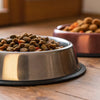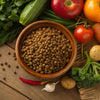How to Get a Dog to Eat Dry Dog Food: Tips for Picky Eaters
- Houndsy
Table of Contents
- Introduction
- Understanding Your Dog's Eating Habits
- Tips for Encouraging Your Dog to Eat Dry Dog Food
- The Benefits of the Houndsy Kibble Dispenser
- Conclusion
Introduction
Did you know that nearly 40% of dog owners report that their furry friends have suddenly refused to eat their food at least once? This common challenge can be perplexing and concerning for pet parents. If you're among those who have encountered a picky eater, you’re not alone. Understanding how to get a dog to eat dry dog food is essential for maintaining their health and happiness.
Feeding our dogs is more than just a routine; it’s an integral part of their care that can significantly affect their overall well-being. While dry dog food offers convenience and balanced nutrition, some dogs may turn up their noses at kibble, leaving us scratching our heads. In this blog post, we’ll explore various strategies to entice your dog to enjoy their dry food and ensure they receive the nutrition they need.
By the end of this comprehensive guide, you will learn about potential reasons behind your dog’s refusal to eat, practical tips to enhance their meals, and insights into their dietary preferences. We’ll also highlight the importance of choosing high-quality food options, like our Houndsy Kibble Dispenser, designed to keep dry food fresh and accessible. So, let’s dive in and transform mealtime into a delightful experience for your pup!
Understanding Your Dog's Eating Habits
Why Dogs Become Picky Eaters
Before we delve into solutions, it's crucial to understand why dogs might refuse to eat their dry food. There are several factors that can contribute to this behavior:
- Health Issues: A sudden change in a dog’s eating habits can be a sign of an underlying health problem. Dental issues, gastrointestinal disorders, or even more serious health conditions can affect their appetite. If your dog is showing other symptoms like lethargy, vomiting, or diarrhea, a trip to the vet is essential to rule out any health concerns.
- Changes in Environment: Dogs are creatures of habit. Any change in their environment—such as a move, new family members, or even a change in routine—can lead to anxiety, causing them to refuse food.
- Food Preferences: Just like us, dogs have their individual tastes. They may develop preferences for certain flavors or textures and may refuse kibble that they find unappetizing.
- Overfeeding or Too Many Treats: If dogs are given too many treats throughout the day, they might not feel hungry during mealtime. Maintaining a balanced approach to treats is important.
- Boredom with Food: Some dogs may get tired of eating the same food every day. Rotational feeding, which involves varying the type of food, can keep mealtime exciting.
Observing Your Dog's Behavior
Take a moment to observe your dog’s behavior around mealtime. Are they excited about their food, or do they seem disinterested? Look for signs of discomfort, such as pawing at their mouth or avoiding food altogether. Understanding your dog's behavior can provide valuable insights into their eating habits and preferences.
Tips for Encouraging Your Dog to Eat Dry Dog Food
1. Make Mealtime a Routine
Establishing a consistent feeding schedule can help your dog develop a healthy appetite. Dogs thrive on routine, and knowing when it's mealtime can create anticipation. Feed at the same times each day, and avoid leaving food out for extended periods.
2. Use High-Quality Food
Not all dry dog foods are created equal. Invest in high-quality kibble that contains real meat, vegetables, and no fillers. Dogs can often taste the difference between premium and lower-quality brands. If you're using our Houndsy Kibble Dispenser, you’ll be able to store your kibble in a way that keeps it fresh, making it more appealing to your pup.
3. Enhance Flavor and Aroma
Sometimes, adding a little excitement to dry food can make a significant difference. Here are some simple ways to enhance the flavor and aroma:
- Warm Water: Adding warm water to your dog's kibble can release enticing smells, making it more appetizing. Just ensure it’s not too hot!
- Broth: Pouring low-sodium chicken or beef broth over kibble can create a flavorful gravy-like dish that many dogs find irresistible.
- Toppers: Consider adding dog-friendly toppers, such as pureed pumpkin, plain yogurt, or small amounts of cooked meat to make the meal more enticing.
4. Limit Table Scraps and Treats
If your dog has developed a taste for table scraps, it can lead to pickiness during mealtime. Gradually reduce the number of treats and scraps you offer, and encourage your pup to eat their kibble instead.
5. Try a Gentle Starvation Method
If your dog is refusing to eat, you might want to consider a gentle approach to encourage them to eat. Place their food bowl down for about 30 minutes. If they don’t eat, remove it until the next scheduled meal. This method can help reinforce that mealtime is the time to eat.
6. Provide a Comfortable Eating Environment
Where your dog eats can impact their willingness to eat. Ensure that their feeding area is quiet and free from distractions. If possible, create a designated feeding space that’s cozy and familiar.
7. Experiment with Different Kibble Variations
Dogs can be picky about the type of kibble they prefer. Experiment with different brands, textures, or flavors. Sometimes, simply changing the food can reignite their interest.
8. Consider the Size and Shape of the Bowl
The design of the bowl can also make a difference. Some dogs prefer wider, flatter bowls that allow them to eat without discomfort. If your dog seems to struggle with their bowl, try a different style to see if it improves their eating experience.
9. Keep Their Teeth Healthy
Dental health is crucial for dogs. If your dog has dental pain, they may avoid eating dry food. Regular dental check-ups and dental treats can help maintain their oral health and encourage them to eat.
10. Consult with a Veterinarian
If your dog continues to refuse food, it’s essential to consult a veterinarian. They can help identify any potential health issues that may be affecting your dog's appetite and provide tailored advice for your specific situation.
The Benefits of the Houndsy Kibble Dispenser
At Houndsy, we understand that feeding your dog can be a daily challenge. Our flagship product, the Houndsy Kibble Dispenser, is designed to simplify and elevate the feeding experience. Here’s how it can make a difference:
- Convenient Crank Mechanism: With our ergonomic crank, you can dispense perfectly portioned kibble without bending down. This feature is particularly useful for pet owners with mobility challenges or those who want to streamline their feeding routine.
- Stylish Design: Our mid-century modern design complements your home decor while providing a functional solution for feeding your dog. No more unattractive bags of kibble cluttering your kitchen!
- Large Storage Capacity: The Houndsy Kibble Dispenser can hold 25–30 lbs of kibble, ensuring you always have a fresh supply on hand. The BPA-free liner keeps food fresh and safe for your pet.
- Auto-Locking Mechanism: The dispenser features an auto-locking mechanism that prevents accidental dispensing, keeping curious pets and toddlers safe.
Explore the Houndsy Kibble Dispenser to elevate your dog’s feeding experience today!
Conclusion
Encouraging your dog to eat dry food doesn’t have to be a daunting task. By understanding their eating habits and preferences, establishing a routine, and enhancing their meals, you can create a positive feeding experience that they will look forward to. Remember to be patient and observant as you try different techniques.
If your dog's refusal to eat persists, always consult with a veterinarian to rule out any health issues. With the right approach, you can nurture a happy, healthy eating routine for your beloved pet.
FAQs
Q: What should I do if my dog refuses to eat for more than a day?
A: If your dog refuses to eat for more than 24 hours, it’s best to consult with your veterinarian to rule out any underlying health issues.
Q: Can I mix wet food with dry food?
A: Yes! Mixing wet food with dry kibble can enhance flavor and texture, making it more appealing to your dog.
Q: How can I tell if my dog is a picky eater or if there’s a health issue?
A: Observe your dog's behavior and any additional symptoms. If they show signs of discomfort or lethargy, consult your veterinarian.
Q: Can I use the Houndsy Kibble Dispenser for wet food?
A: The Houndsy Kibble Dispenser is designed for dry kibble. For wet food, consider using a separate storage solution.
Q: How can I encourage my dog to eat if they have dental pain?
A: If you suspect dental pain, consult your vet. They may recommend softer foods or dental treatments to help with pain management.












